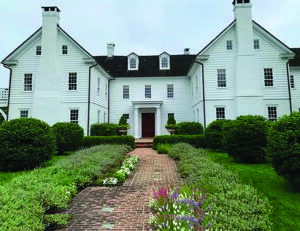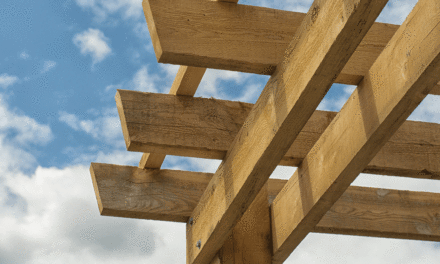
Starting with a sturdy but modest homestead built in the very late 1700s, there have been numerous additions and renovations over the years to Chloras Point Farm: 1830, 1870, and several in the 20th century. (Photo courtesy Maryland Home and Garden Pilgrimage)
Talbot County is steeped in more than 350 years of American history. Named in honor of Lady Grace, wife of Sir Robert Talbot and sister of Cecilius Calvert, second Lord Baltimore, Talbot County was settled by the English about 1661.
With more than 600 miles of picturesque waterfront, the county’s manor houses along the creeks, rivers and bays face the waters that brought guests and trade from across the Chesapeake and around the world.
In the Maryland Home and Garden Pilgrimage, a selection of those homes — four in Trappe, three in Easton — will be showcased Saturday, May 11 during the group’s Talbot County Tour.
Advance reservations are required and must be received by May 1, 2024.
Visit https://www.mhgp.org/tours to reserve tickets and purchase meals.
Advanced tickets for the tour are $41.75 per person. Tickets purchased the day of the tour are $45 per person. Individual houses may be visited for $20 each.
Here is a little bit about each stop on the tour.
Chloras Point Farm, 26900
Chloras Point Rd., Trappe
From the tip of Chloras Point, water stretches out far and wide. Once part of the Hyer Dyer Lloyd land grant of 1659, Chloras Point Farm not only enjoys broad views but a protected vantage point thanks to a generous lagoon in front of the house and a sandspit off the Choptank River that creates a private harbor. The farm is named after Clora O’Dora who bought the original 600 acres spanning Dividing Creek to Island Creek from the Lloyds in June 1666. Starting with a sturdy but modest homestead built in the very late 1700s, there have been numerous additions and renovations over the years: 1830, 1870, and several in the 20th century. The owners have gradually remodeled to meet 21st century needs without compromising history.
Trappe Landing Farm
28534 Granville Lane, Trappe
The current stewards of Trappe Landing Farm, acquired the 108-acre property in 2018. The estate consisted of a sprawling farmhouse, tillable land, woodlands, the original smoke house, a dock and 700 feet of waterfront at the headwaters of La Trappe creek. The existing original farmhouse dates to 1850. In 2000, a major renovation included planting 120 trees and building a large addition which included a living room, dining room, game room, and porch on the first floor and an office, primary suite and deck on the second floor. The current owners planted 450 trees and seamlessly integrated a three-bay garage, a 5,000 square foot barn with adjacent vegetable garden and guest house.
Ferry Farm House, 29793
Bolingbroke Point Dr., Trappe
Ferry Farm House, one of fifteen homes built before 1731 still remaining in Talbot County, is among the earliest gambrel roof dwellings in the area. The original tobacco barn, believed to be one of only two existing today in Talbot County, adds to its historic significance. The house originally operated as an Inn and Tavern for those waiting for the ferry across the Choptank River to Dorchester County. The ferry rights, granted to landowner Henry Bullen in 1722, were later owned by William Akers until the early 19th century. He and his wife, Ann, were the first to use the building as a residence. Alexander Highley, owner of the house and 160 acres of land in the 1900s, ultimately sold the house and subdivided the land. The original house, three bays long and two bays wide and laid in English bond on a brick cellar, was supported by unsawn white oak logs with their original bark.
In the 1940s, the eastern wing was added from what had originally been a small horse barn. The original front door of the house faced the water and the rear door would have looked out on fertile fields and sheep pastures.
The current owners acquired the property in 2012.
Lloyds Landing, 30975
Lloyds Landing Rd., Trappe
Lloyd’s Landing, one of the most significant examples of early 18th century architecture in Talbot County, was erected between 1720-1730. One of only eight structures from that era still remaining in the county, Lloyds Landing is the oldest and best preserved. Built for James Lloyd, the son of James Lloyd and his wife Anne Grundy of Hope House, this fascinating house has a steep and unusual roof pitch that extends over a brick terrace. The location enabled James Lloyd (the younger), known as “the Mariner,” to keep an eye on his warehouse and wharf on the Choptank River. There have been reports that interesting artifacts from the Choptank tribe have been picked up near the wharf indicating a large Indian encampment. In 1841, the Lloyd Family sold the property to William Hughlett, whose descendants (through the Hardcastle and Henderson lines) own the property today.
Canterbury Manor
5985 Canterbury Dr., Easton
Canterbury Manor gleams bright white against a velvety green lawn that forms a teardrop in front of the house. The teardrop is encircled by a graceful driveway that delivers visitors to the front of the elegant two-story Colonial Revival mansion.
Built in 1906 by Colonel F. Carroll Goldsborough, the two-story Colonial Revival mansion at Canterbury Manor stands on land originally granted to Samuel Graves in the mid-17th century and subsequently laid out in 1659 for Richard Tilghman, a surgeon in London and later a Maryland planter.
Elliot Wheeler, who owned the property from 1915-45, is credited for creating its present appearance. Built in the Colonial Revival Style, the central portion of the house has a pedimented ionic portico with a large lunette in the pediment. There are wings on the east and west, with a double veranda on the west—all designed to take advantage of the cooling breezes in the time before air conditioning. A grand foyer with original glass frames a sweeping view of the water and creates a dramatic entrance. While formal in design, there is an intimate charm throughout the house. The outside is welcomed in with views of the gardens, lawn and Trippe’s Creek beyond. Urns planted with colorful flowers add brightness to a background of tall evergreens.
Ellenborough
6643 Ellenborough Rd., Easton
Located on Peachblossom Creek, with wide western views, the 54-acre Ellenborough estate is approached by a magnificent, half mile drive lined with Norway Maples planted in the early 19th century by the original owner.
The current house replaced the plantation home built by Matthew Goldsborough around 1860 which was named “Ellenborough,” honoring his wife Eleanor Goldsborough. That house burned down in 1905 and was virtually abandoned until more than two decades later when it was razed to make way for the current structure, whose owners kept the name Ellenborough. Built in 1928, Ellenborough, a fine example, is a two-and-a-half story central brick mansion in the Colonial Revival style with a graceful five-bay facade.
The current owners have worked hard to create an elegant interior that embodies its historic past but with modern updates, such as the spacious kitchen and adjacent breakfast/meeting room. Historic details include wide random-planked yellow pine floors laid in a tongue-and-groove pattern and a dramatic, sweeping staircase in the central hallway.
219 S. Hanson Street
219 S. Hanson St., Easton
Boasting a brick facade, slate roof, copper gutters, and double hung windows, the home at 219 S. Hanson Street was built in 1938 for Dr. William D. Noble, a prominent surgeon and Chief of Staff at Easton Memorial Hospital, and his family. The custodians of this historic home, bought the house in 2021 and have meticulously undertaken a masterful renovation while honoring and preserving the many architectural details that define its character. The wrought iron railing in the front still bears the letter “N,” a subtle nod to Dr. Noble.
During the painstaking renovations, the owners found a collection of letters penned by one of the teenage daughters of Dr. William Wood, the second owner.
The owners carefully preserved the letters, and they are soon to be reunited with their original author, adding a touching layer of history to this home.
* * *
A box lunch will be offered for $17 at the historic Scotts United Methodist Church, at 3748 Main Street in Trappe.
Tourgoers also may pay at the door with cash, but can only do so with advance reservations, by emailing your request to the Madeleine Cohen, at scottsumc2023@gmail.com.
Proceeds from the Talbot County Tour will be used to fund preservation and restoration projects at two churches in Trappe: Scotts United Methodist Church and St. Paul’s Church, White Marsh Parish.
The original structure of Scotts United Methodist Church dates back to the 17th century and belonged to the Quakers of the Trappe area.
The oldest church on the Eastern Shore in which public worship was conducted was White Marsh Church which served Easton, Trappe and Oxford. It first was built in the 1670s north of Easton and then a new church building of White Marsh Parish was erected in Trappe and named St. Paul’s Church in 1858. A brush fire destroyed the building in 1897.
St. Paul’s Church, White Marsh Parish and the Old White Marsh Cemetery wall ruin need brick restoration and repair due to deterioration over time and “souvenir theft” of up to 75 percent of the original White Marsh brick addition.
For more information, contact the pilgrimage group at 443-534-8981 or mhgp@aol.com.





